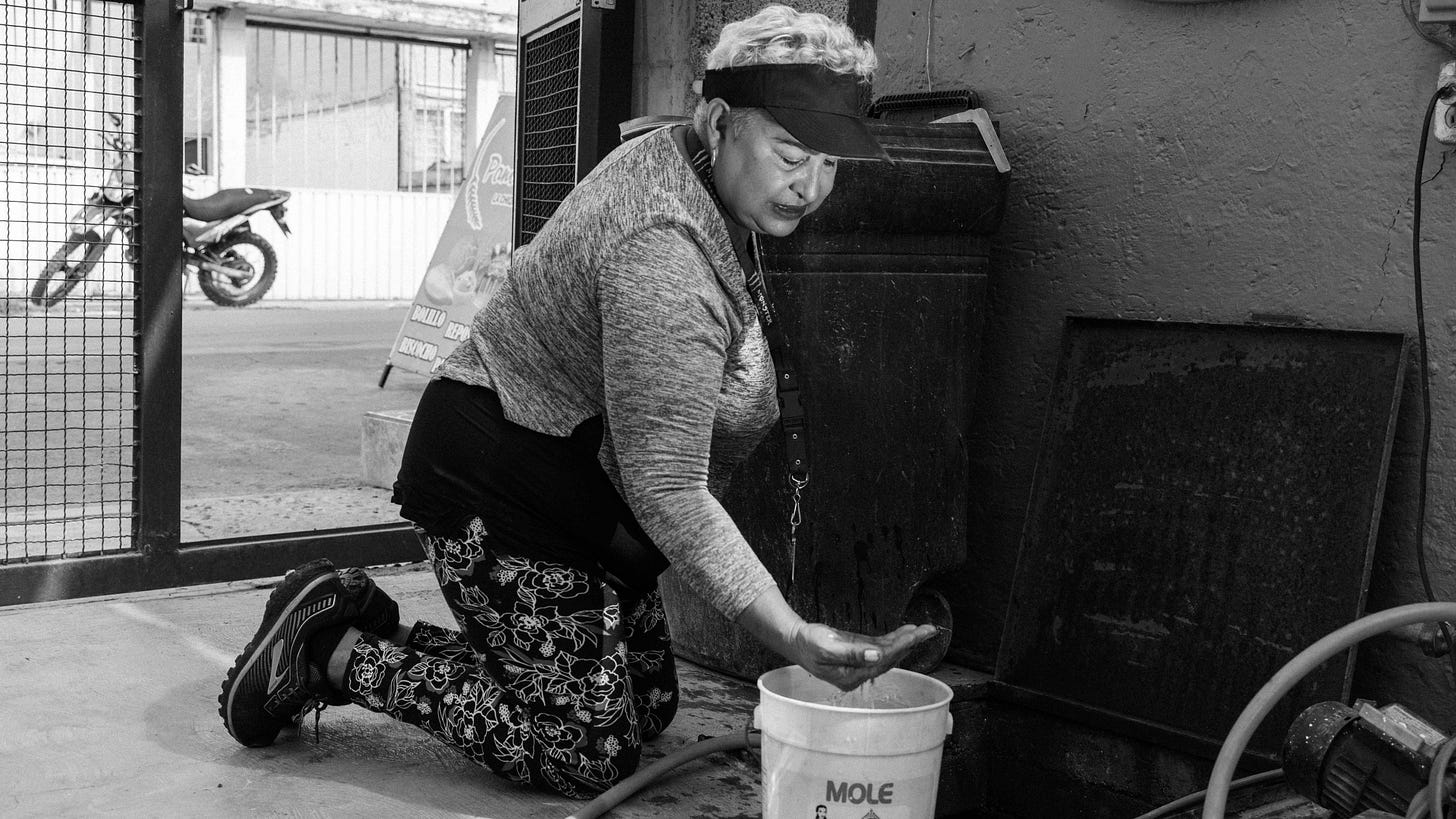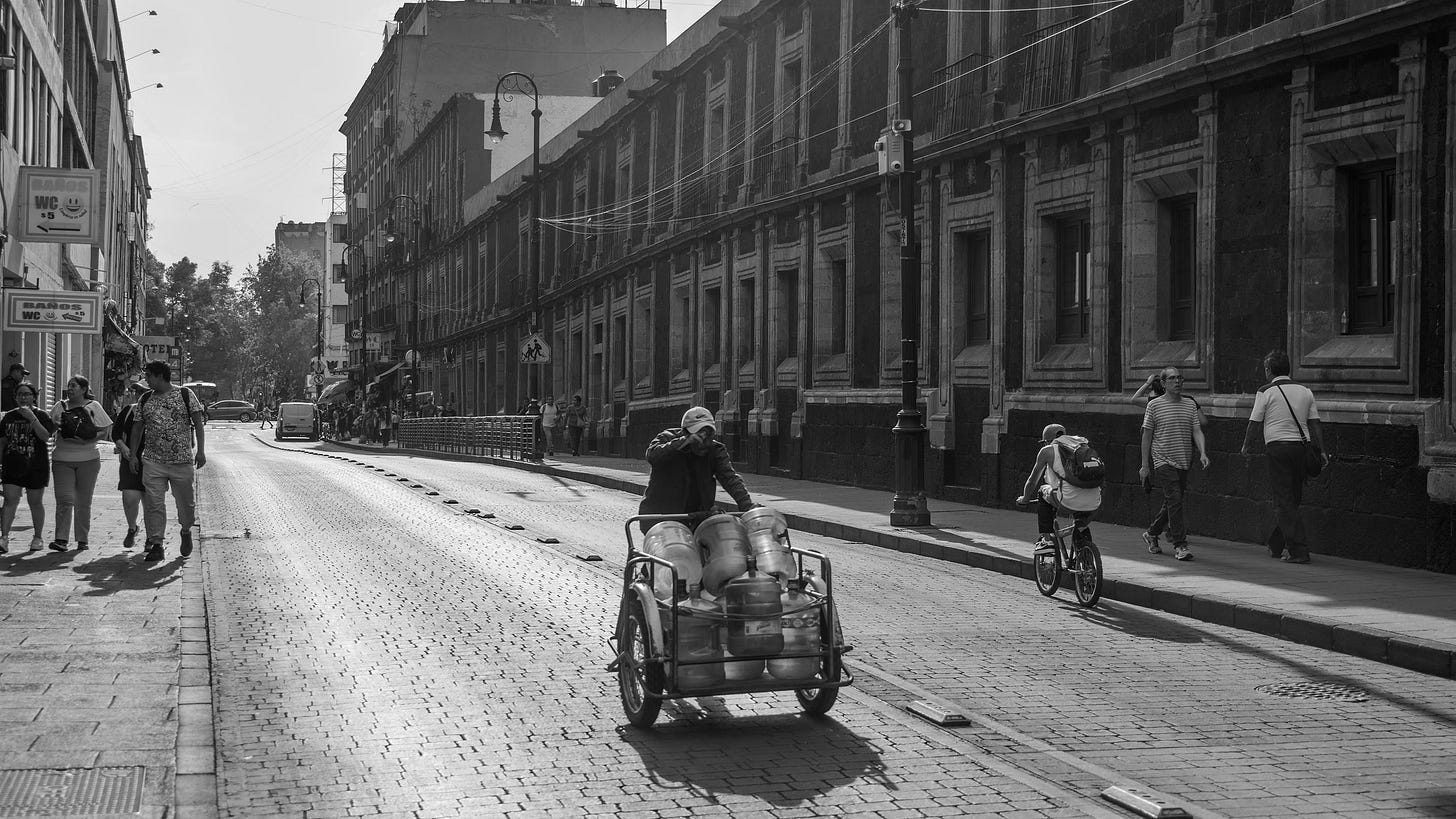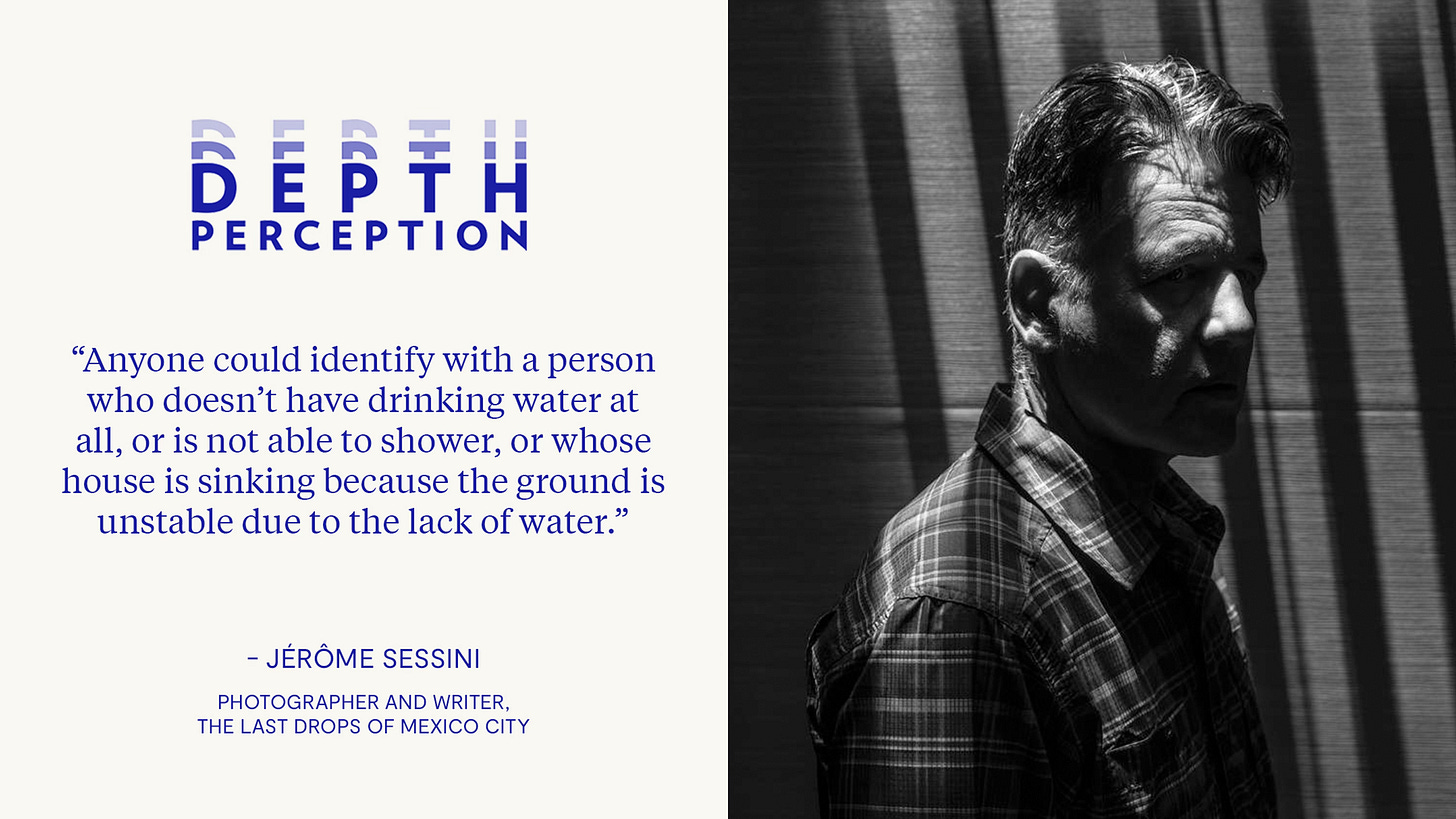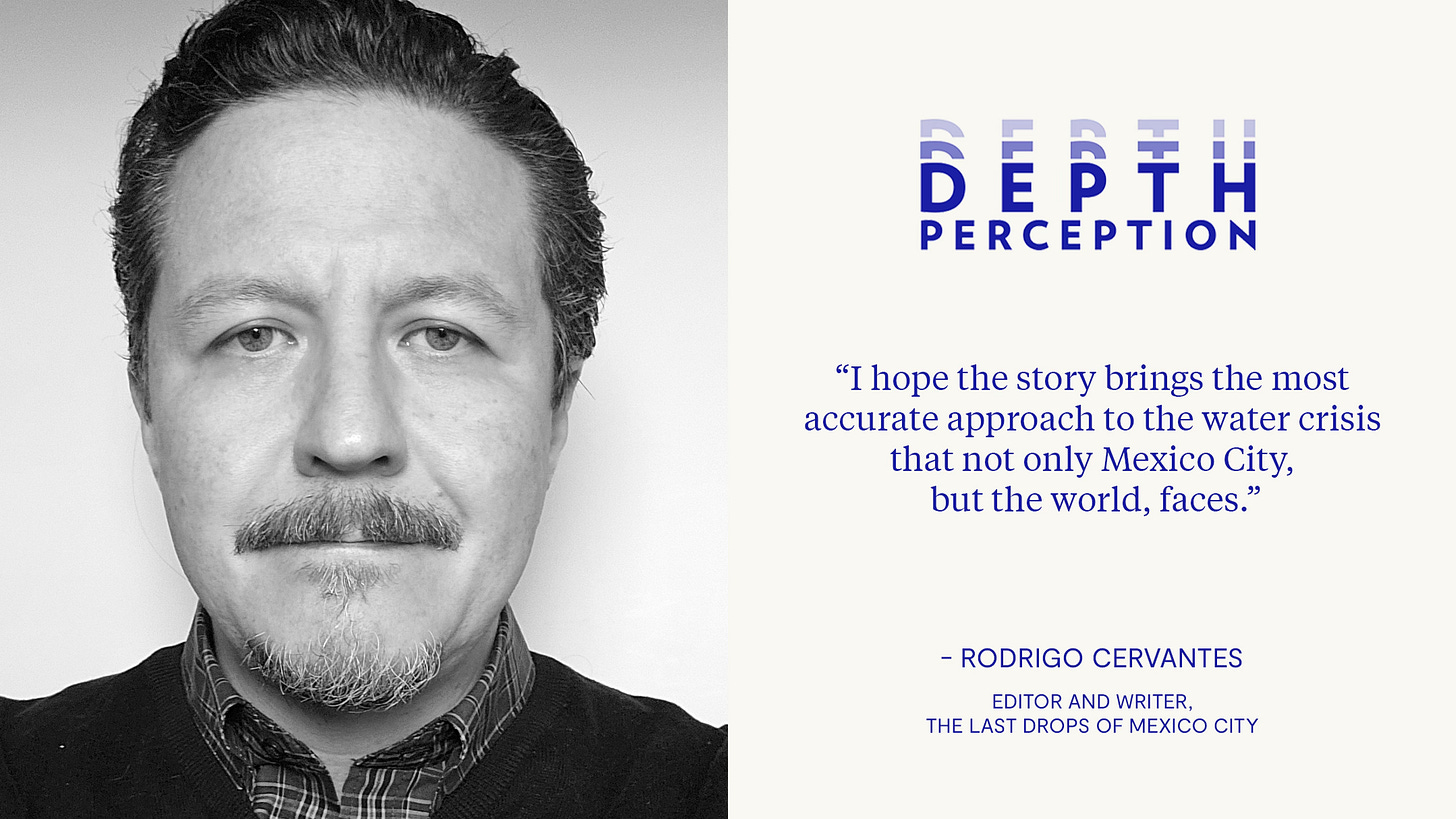Focusing on a crisis: How two journalists paired up to document Mexico City's water shortage
Award-winning Magnum photographer Jérôme Sessini and veteran multimedia journalist Rodrigo Cervantes bring drought and climate adaptation into focus in Long Lead’s latest feature.

When Jérôme Sessini aims his camera at a crisis, the world takes notice. Since the early 2000s, the photographer, who is a member of the Magnum Photos cooperative, has documented some of humanity's most pressing calamities, from drug cartel violence in Mexico to war zones in Syria, Iraq, and Ukraine. But his latest project turns to a different kind of emergency: the slow-motion collapse of Mexico City's water system.
In “The Last Drops of Mexico City,” a visual essay for Long Lead, Sessini's black-and-white images capture a megalopolis of 22 million struggling with profound thirst. Working alongside journalist Rodrigo Cervantes, a veteran reporter who served as Mexico City bureau chief for NPR member station KJZZ, the duo presents a city originally built on a lake system that now finds itself sinking as its reservoirs hit record lows.
The story's visuals-first approach offers a template for climate journalism — one that bridges the often difficult gap between abstract environmental trends and immediate human experiences. Paired with Cervantes' reporting and editing, the project documents both a specific urban crisis and a warning for cities worldwide facing similar climate pressures.
In this edition of Depth Perception, we speak with both Sessini and Cervantes about their collaborative process, the challenges of documenting environmental crises, and how they avoided both apocalyptic sensationalism and complacent optimism in telling this urgent story. —Parker Molloy
How did your backgrounds and experiences shape your understanding of Mexico City's water crisis?
Jérôme Sessini: I've been working in Mexico since 2001, basically every year traveling there and covering different subjects. One of the most important was the drug cartel crisis between 2005 and 2012, along with various other topics. The water crisis was something that was already happening over the past 20 years in Mexico. But last year it reached the most dramatic point because the water level at the main reservoir of Mexico City dropped to the lowest point ever. That's why I decided to address this topic.
Rodrigo Cervantes: As someone born and raised in Mexico City, I grew up aware of the problems that the city has faced for decades, sometimes centuries. Water shortages is one of them, but the experience as bureau chief allowed me to get a closer look at the issue, particularly as the citizens' concerns started to grow with global warming and overpopulation.
How did your partnership come about, and what was your collaborative process like?
Sessini: With Rodrigo, we had long back-and-forth exchanges. I was writing the text with all the information I gathered in the field, and Rodrigo was helping to edit and write properly, as I'm not a writer, I'm a photographer. I mostly provided the information, wrote a draft, and then Rodrigo went deeper. He also contacted researchers and scientists in Mexico to get more information and to make the text more accurate.
Cervantes: Jérôme's expert lens collected a series of beautiful black-and-white images showing intimate scenes connected to the water crisis. His photographs basically bring an amazing visual narrative, while I helped build a written narrative to go deeper into the situation and provide — no pun intended — a bigger picture.
Mexico City's water crisis has been covered by various outlets. What aspects of the story did you feel were being overlooked in previous reporting?
Sessini: I think the difference is that many media covered the topic, but they did it in a very short period of time, maybe a few days. I had the luxury to work for a month on this topic, and I could spend more time in places like the Mexico City suburbs, specifically Ecatepec. For instance, I got pictures of people stealing water in public areas, and this is something I hadn't seen before. I met people directly at their homes in Ecatepec, and I was able to gather information directly from specific individuals telling me their stories firsthand. The time I put into the story was maybe the difference.
Cervantes: The story has been usually either overdramatized or underrepresented, with either exaggerated and apocalyptic views to attract audiences or, in contrast, government-pleasing and public-appeasing views. Journalism faces a crisis, and a big part of it comes from how we report and build our narratives. This story brings the right balance and captures a better and more complete vision of Mexico City's current situation, with all the concerns — but also hopes — that surround it. We also constructed it with the hopes of generating awareness to people living in other megalopolises — let's say Los Angeles, for instance — where water distribution is already becoming a concerning issue.
Were there any particular challenges in reporting this story that you didn't anticipate?
Sessini: Yes. For instance, in Ecatepec and in Xochimilco, I was with another photographer, a Mexican local who was working with me as a fixer. Every time we went somewhere, we had to make sure we had a contact and could go without any security troubles, because these areas are very tense. Crime is everywhere, and we could have had security issues. It was also difficult sometimes to get people to talk to me. People are very worried about strangers or even local people. People are afraid to talk.
Cervantes: Perhaps our biggest challenge was to work on different time zones. The team was spread across four or five different time zones at some point, which sometimes represented a coordinating issue. However, good communication and technology made things smooth.
The latest from Long Lead: ”The Last Drops of Mexico City”

Originally settled in the 1300s as an island in the middle of a series of lakes, Mexico City is now a megapolis that’s home to nearly 22 million people. Served by a water system pushed to its limit, its citizens find relief in unheard of ways, like pulling unfiltered water from ground wells and buying it by the bottle on the black market.
In “The Last Drops of Mexico City,” Magnum photographer Jérôme Sessini documents the Mexican capital’s diminished drinking water supply, fixing his lens on the people impacted most by this arid new reality. What he discovers is a complex, longstanding crisis rooted in a number of exacerbating factors, from climate change and over-development to pollution and chaotic population growth.
Bolstered by reporting from Rodrigo Cervantes, a former Mexico City bureau chief for NPR member station KJZZ, Sessini captures lakes dried up, reservoirs drained low, and taps running dry, as the people who relied on them suffer by ingesting water that’s not fit for consumption. Meanwhile, the parched soil beneath struggles to support the weight of the megalopolis. Without enough water to keep it afloat, Mexico City is literally sinking under the weight of its own ambition and growth. Learn more at mexicocitywater.longlead.com.
When reporting on environmental crises like this one, how do you balance conveying the urgency without falling into disaster fatalism?
Sessini: I try to be as close as possible to the reality that I witness without using artificial effects or trying to over-dramatize the situation. It's difficult to please everyone, but I try to stay close to the reality I see myself.
Cervantes: It all starts by being observant and a good listener, while looking for balance as much as possible. While sometimes you might face a true, horrifying catastrophe, in many other cases (this one included) you need to put together different parts of the puzzle to truly understand it. Another very important aspect, in my opinion, is to try to bring solutions, positive actions and hopeful perspectives as part of the story. A good story does not always need to be a tragic one, and sometimes we as an audience need and deserve a little push towards light — more so in dark and confusing times like the ones we currently experience.
This piece is described as a “visuals-first approach.” How did that framing influence your work compared to more text-heavy journalism?
Sessini: When I make a photo essay, I think as a photographer. Sometimes I work with a journalist, but in this case, I was on my own initially. I was gathering as much information as possible, but not thinking as a writer. We had to find the right balance with Rodrigo, where the most important part for Long Lead is the visual part, the photography. We wanted the photography not just to be an illustration of the text, and the text not just to be a complementary explanation of the photos. It's not an easy balance to find, but I think we achieved it.
Cervantes: It is very common in journalism that the photographer takes the copilot seat to merely illustrate the story. In this case, we had a well-seasoned professional leading the work by collecting the images first, followed by a text that would give a deeper and broader perspective on what we see.
Climate change stories often struggle to connect abstract global trends with tangible human experiences. How did you work to bridge that gap?
Sessini: I focused on photographing how people were affected by the lack of water. I didn't want just to have landscapes or very technical images. I tried to find the right balance between the human element in my photo essay and the landscape part, along with the testimonies of key people in the text. I think anyone could identify with a person who doesn't have drinking water at all, or is not able to shower, or whose house is sinking because the ground is unstable due to the lack of water.
Cervantes: Jérôme's experience while taking the photos brought the more “tangible” aspects. The story we wrote focuses on blending that vision and human-centred narrative with abstract or complex issues — from historical facts to scientific concepts — but without an academic approach.
What do you hope people take away from this visual essay beyond simply awareness?
Sessini: To make a project, it must first and foremost have an impact on me, because that part is very personal. Then, of course, when the topic affects an entire country like Mexico, I hope to bring awareness to as wide an audience as possible. Everyone speaks about climate issues, but sometimes it's something very abstract. I used this topic to make it concrete, so people can understand and identify themselves with the problem.
Cervantes: Jérôme’s images are, in my opinion, of great beauty, which will help strengthen the message and make it more memorable. I hope the story brings the most accurate approach to the water crisis that not only Mexico City, but the world, faces. I also hope the essay can bring more reflection and debate on how our actions have reactions, and also on how, despite the obscurity that may seem to condemn us and surrounds us, there is always someone carrying a torch, eager to lead us towards the right exit.
Further viewing from Jérôme Sessini
“The Second Battle of Fallujah: 15 Years On” (Magnum Photos, Nov. 7, 2019)
“Opioids in America: A Lifelong Addiction” (Magnum Photos, Oct. 22, 2019)
“Maidan: Five Years On” (Magnum Photos, Feb. 18, 2019)
“Saving Nature to Save Humanity” (Magnum Photos, Jan. 16, 2018)
“A Forgotten France” (Magnum Photos, March 13, 2017)
Further reading from Rodrigo Cevantes
“Finding a Home While Building a Life” (Capital & Main, Sept. 26, 2024)
“The Pleasure and Pain of Chiles, Cultivated by Colonialism” (Capital & Main, May 28, 2024)
“Meet Sad Breakfast, the Mexican band influenced by L.A. that you might not know (but maybe you should)” (De Los, Dec. 13, 2023)
“What do ‘Blue Beetle,’ Quetzalcóatl and Chapulín Colorado have in common?” (De Los, Aug. 14, 2023)
“Artists in Mexico City are trying to preserve the capital city's rich soundscape” (NPR, March 17, 2022)







